
She lost an eye to cancer, but gained a sense of adventure as bold as Alaska

July 06, 2021 • 9 min
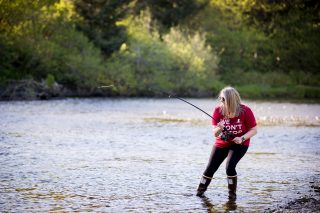
KODIAK ISLAND, Alaska — It takes a lot to rattle Brandi Noe. Sure, there was that time a bear ran by the window as she was teaching her class of first graders. “I’m like, Oh, my gosh, bear! Just out of shock,” she said, laughing about it now.
But that was after Noe and her Coast Guard husband, Jason, and their daughter first moved to Kodiak Island — home to the Kodiak bear, the world’s largest brown bear, weighing as much as 1,500 pounds and standing up to 10 feet tall.
“But they’re really peaceful creatures,” she said, having shared the island with them for some seven years now over two stints. “They will come at you, if you prompt them. You’ve got to just be bear-aware and pretty smart. Give them their space.
“I don’t think they’re quite as aggressive as, say, a grizzly or polar. They’re a little more, like, chill. They’re on island time.”
This is how Noe, 42, sees the world, through her one good eye — with a willing spirit of adventure, a wry sense of humor, and a keen appreciation that nothing is guaranteed in this wild ride called life.
As a 4½-year-old girl growing up in Alabama, she was diagnosed with retinoblastoma — a rare cancer of the eye — and treated at St. Jude Children’s Research Hospital. There was heightened concern, she said, because of the size of her tumor and the fact that she was older than most children diagnosed with the disease.
“The retina had begun detaching and it was feared that the cancer may have spread to my optic nerve,” she said. “The only solution was enucleation (removal) of the eye and removal of my right optic nerve.”
So began a life with one working eye and one prosthesis, and everything that entails — not just how Noe would see, but how others would see her: differently.
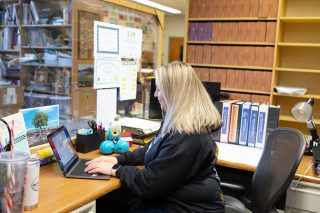
“At times it was near impossible to be a normal kid,” she said, but, “When doctors — not at St. Jude — would say ‘She can’t play that sport’ or ‘She should not do this’ … I did. I pushed through the barriers and I never let bullying or fear stop me from doing the things in life I wanted to do.
“Kind of like high school with sports. They’re like, you really shouldn’t play basketball, you shouldn’t cheer. I’m like, then I’m going to, because you’re putting a limitation on me.”
That’s why Noe, a teacher and now mom to two daughters, who grew up in a part of the country where Bear means Bryant (as in the late football coach Paul 'Bear' Bryant), is somehow right at home, some 3,200 miles away, in a place that doesn’t just invite dauntlessness but very nearly demands it.
Kodiak Island has beautiful mountains, and Noe loves to climb them. “But it makes my husband really nervous,” she said, laughing.
After all, the loss of her right eye and other complications of her disease can affect the most basic aspects of life — walking through her own home, for example. “I’m pretty clumsy. I bounce off walls a lot,” she said. “My depth perception, I’ve found as I get older, is a struggle.”
And yet, she’s able to drive, climb mountains, and be altogether outdoorsy (more on that later.) Oh, she’s careful, all right. She’s self-aware, as well as bear-aware. But …
“I don’t let it hold me back,” she said. “I never have.”
St. Jude in Alaska
St. Jude is buildings on a campus in a city, a physical place, a point on the map. But for many of its patients, it’s also an experience, a lesson in living, a means to navigating the world. It is a map. They take it with them when they go.
Shaped by the care they received, buoyed by their second chances, they know better than most how precious life can be. It’s why so many former patients go on to live with such pluck and purpose. And why they tell their stories along the way, stories of hope, and the healing made possible by St. Jude supporters across the country.
Noe’s story is one of childhood trauma, but also of the love and support she felt at St. Jude. She remembers fainting every time she went for lab work, but also waking up in her hospital bed one day to the sight of “a room filled with balloons, flowers and stuffed animals.” She remembers, years later, becoming friends with a fellow former patient named Scott Hinshelwood, who taught her a crucial lesson of cancer survival — humor.
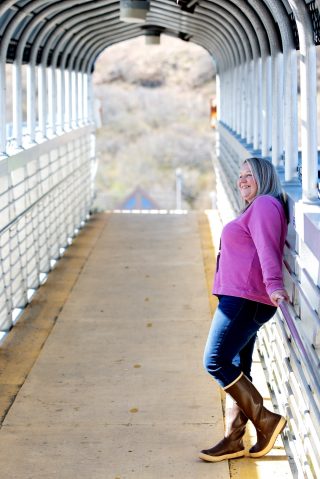
“I met him in my early 20s, and I think his spirit kind of inspired me,” she said of Hinshelwood, who was treated at St. Jude for osteosarcoma, a bone cancer, and now works for ALSAC, the fundraising and awareness organization for St. Jude. “He was kind of that person who showed me it was OK to laugh about it. It’s OK to make jokes about it.”
And so she’ll sometimes introduce herself by saying, “Hi, I’m Brandi with one i.”
St. Jude founder Danny Thomas, whose day job was making people laugh, would have loved Noe.
But surely she wouldn’t find a ready audience for her St. Jude story in the Last Frontier. Surely few people living on an island in the Gulf of Alaska would be familiar with a children’s research hospital in the Mississippi River city of Memphis, Tennessee.
But in fact, St. Jude was already there. In Alaska, and even on Kodiak Island. In the hearts of the people, and on the radio waves that connect them.
“You’re the lifeline,” said native Alaskan Ellen Simeonoff of radio’s role on an island without local TV, “to what local businesses are doing, what events are happening, and helping to drive the economy. And connect people, not just to their businesses, but to each other.”
Simeonoff is general manager at Kodiak Island Broadcasting, which has staged Country Cares for St. Jude Kids radiothons since 2004. This year, KVOK and KRXX raised more than $35,000 for the cause — or about $6 for every person in the city of Kodiak.
Simeonoff calls St. Jude “the ideal mission,” and through the Country Cares program has made numerous visits to the Memphis campus. She was in her first stint at the Kodiak stations, as a salesperson, when the radiothon was launched by Matt Wilson, another native Alaskan.
Wilson’s first experience with St. Jude radiothons was as a 16-year-old intern at Anchorage’s KBRJ in 1997. A radio-loving teen, he had, by his own account, begged and bugged his way into an intern gig that didn’t actually exist. Then he cajoled his way onto the air during KBEAR’S radiothon, which at the time was held at a local mall. His pitch to his bosses — I’m a teenager, just like many St. Jude patients.
Nearly a quarter-century later, Wilson, now based in Kenai, is an elder statesman of St. Jude support in Alaska. He’s made the 3,200-mile trip to St. Jude — roughly the same distance as from Kenai to Montreal, or Memphis to Lima, Peru — more than a dozen times, and has an idea why the love for the cause is so deep in a place so distant.
“The giving nature of Alaskans just seems to be out of this world,” he said. Add to that, he said, the St. Jude model — providing not just treatment, but travel, food and housing, and not just housing but a sense of home, of normalcy, for the whole family.
“You have a place, really for us, that’s almost like halfway across the world,” Wilson said. “So when you’re so far away, having the reassurance, I think that impacts people stronger the farther away you get. Knowing that OK, St. Jude is there, and knowing that if my kid gets cancer, they’re going to put them on a plane, and it doesn’t matter how long it’s going to take, they’re going to get them to Memphis, they’re going to take care of my kid.”
Wilson started the Kenai radiothon when he moved to that market, as he had done in Kodiak. He’s general manager of the KSRM Radio Group, whose country station, KWHQ, was joined for the first time by its rock station, KFSE, and set a market record with more than $60,000 raised with this year’s radiothon.
“It’s been years, if I think about it, that I’ve had a person come to me and say, ‘Why are we giving to a hospital in Memphis?’” he said. “Those questions just don’t come up anymore.”
Noe has told her St. Jude story during radiothons — just one of the ways she supports the cause, in addition to having led a St. Jude Math-A-Thon fundraiser at school, and contributing each month, along with Jason, as St. Jude Partners in Hope.
But to see others — strangers to St. Jude, thousands of miles removed — so devoted, well …
“It actually gives me chills,” she said, “to think that people who will maybe never lay eyes on the campus or know anything about the city of Memphis or the state of Tennessee, that they’re supportive of children going through such a terrible time.
“It’s amazing. It makes me so proud to be part of a community that finds that important.”
Blue waters, dark days
They say eyes are the windows to the soul. Noe’s seems as bold as the place she now calls home.
“Summer time is beautiful here,” she said. “We have a boat, so we go out fishing. I’ve actually out-fished my husband several times, so he’s pretty jealous about that. Lot of hiking. Lots of mountains. It’s so green and beautiful here in the summer.
“We have gray whales. There are orcas. We have a lot of otters and sea lions. It’s pretty crazy.
“We catch a lot of halibut here. The one I caught was, I think, about 75 pounds. It almost pulled me in the water but I managed to get it on the boat.
“It’s like something out of a story.”
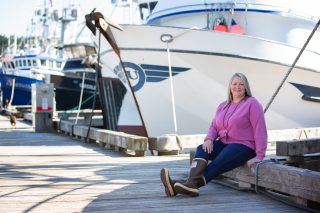
Kodiak Island is the second-largest island in the U.S., behind only the Big Island of Hawaii, but you can’t reach most of it by car. The Kodiak National Wildlife Refuge, which covers two-thirds of the island, includes seven major rivers, 117 salmon-bearing streams, 16 lakes — and no roads. The island’s largest city, Kodiak, where Noe lives and teaches, has a population of only about 5,800 — and the occasional visit from one of the island’s namesakes.
“Oh, yeah. Oh, yeah,” she said of Kodiak bears, which total about 3,500 on the islands of the Kodiak Archipelago. “We have the rolling trash cans in town, so a lot of people call those bear lunchboxes. So they do come into town. They’re looking for an opportunity to eat pretty much anything.
“We were doing a fishing tournament last year with kids. At one point we had a bear on three of our four sides. So we were slowly backing away. We had a fish to give them if they came at us."
And, “There have been times when we’re out at recess and we’re like, Uh, guys, we need to move on in. Blow the whistle three times and get back inside, because you’ll see them in the distance. Not often, but it happens. It definitely has happened.
“Between that and eagles.” She laughed. “We have a lot of eagles here. They like to frequent our playgrounds, as well.”
Any trouble with the eagles?
“They’re pretty awesome. They’re kind of like the symbol of our country. But when you see them on the ground shredding fish and you see how they’re really scavengers, you’re kind of like, Wow, I never saw that side of them.
“They’re pretty vicious creatures. They will take your small dogs and cats out of your yard. So I guess just also eagle-aware.”
Life on Kodiak Island can be a bear in other ways. You’re isolated — not just from the Lower 48 but from your own state. A ferry ride from Kodiak to Homer (aka “Where the land ends and the sea begins”), on the Kenai Peninsula, is nine and a half hours.
And there’s the ice in the winter. The darkness, too. “You get the 18 to 20 hours of sunlight in the summertime. But then come winter time it’s reversed,” she said, “and you may have four or five hours of sunlight and the rest is dark. That can be tough.”
But so, as we’ve seen, is Noe.
Forging ever on
The Noes — Brandi, Jason, 15-year-old Emma and 8-year-old Piper — are in their last year in Alaska. Jason’s on his twilight tour with the Coast Guard, then he’ll retire and they’ll move back to the Lower 48, to the South, closer to family.
“It’s kind of bittersweet,” she said. “I will miss this little island. But I miss being around family. I miss being close to home.”
And she’ll be missed in Alaska, no doubt.
“She’s bright, shiny, happy,” said Simeonoff, the Kodiak radio GM. “She was actually my granddaughter’s kindergarten teacher.”
Before the big move, though, Noe will likely have completed her Master’s degree in Educational Leadership in Higher Education — despite such lingering effects as a short-term memory deficit and executive function disorder, which forces her to carefully plan and make notes lest she forget key details.
“It’s taken me longer to accomplish some of the things that I’ve wanted to accomplish,” she said. “But you know, it’s just all about focus and setting goals and not letting only having one eye be the thing that holds me back.
“If anything, that’s the thing that pushes me forward.”
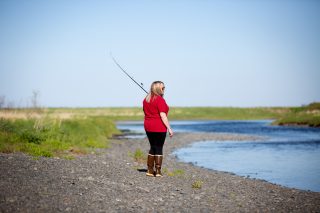
She was recently promoted by the Kodiak schools, from teaching at a single elementary school to teaching district-wide in a program for gifted and talented students. “I’m teaching kids to code, to do basic programming, and then understanding concepts around basic robotics,” she said. “It is very cool.”
Someday, she’d like to teach in college. She also envisions being even more involved with St. Jude, once she’s back home in the South, closer to family.
If we know her at all, she’ll also continue to look for mountains to climb — figurative and literal ones.
And if someone tells Brandi Noe she can’t do something, or shouldn’t even try, we know just what she’ll say.
“Yeah, watch me.”

